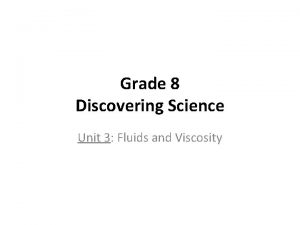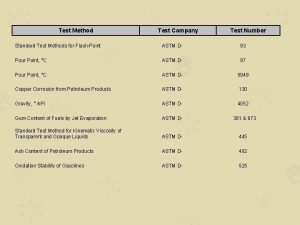Science Grade 7 Unit 5 Test 2017 2018
















- Slides: 16

Science Grade 7 Unit 5 Test 2017 -2018

1 Mice can produce a litter of offspring as often as every 20 days. An elephant can produce one offspring every two years. Which of the following BEST describes the advantage of having fewer offspring? A. There are fewer offspring for hungry predators to eat. B. Parents can pay more attention to each offspring. C. Offspring receive only the best traits and adaptations. D. Only one offspring will increase its survival rate. Page 2 GO ON

2 A few years ago the population of male blue moon butterflies on the island of Samoa declined. One hypothesis for the decline of the male butterflies is that a parasite infected the cells of female butterflies. The parasite was passed to offspring through the females’ eggs and killed the male butterfly embryos. At one point during the decline, nearly all the butterflies in the population were females, but after five years the number of males in the population increased significantly. Which explanation most likely accounts for the increase in the number of male butterflies in the five years after the initial parasite problem? F. Male butterflies in the population that survived were able to prey on the parasites living in the females’ egg cells. G. Female butterflies in the population that survived had a genetic adaptation that allowed them to transform into male butterflies. H. Male butterflies in the population that survived had a gene that made them resistant to the parasite, and they passed the gene on to their offspring. J Female butterflies in the population that survived were able to protect the male eggs from the parasite and provide extra care for the male offspring. Page 3 GO ON

3 Some students collected leaf samples. The students used the leaf identification key shown below to identify a leaf sample. Based on the identification key, which type of tree is this sample from? A Ginkgo B Honey locust C Horse chestnut D Black maple Page 4 GO ON

4 Some species of flowers have markings that are visible only to insects with the ability to see ultraviolet light waves. These markings help the plants — F. avoid parasitic insects G. attract pollen-gathering insects H. seek out moisture in the soil J create a strong scent to attract bats Page 5 GO ON

5 A student examines the winged insect shown below. Based on the dichotomous key, in what order should this insect be classified? A. Mantodea B. Raphidioptera C. Coleoptera D. Lepidoptera Page 6 GO ON

6 The tails of animals can serve many important functions. They are mainly used in balance and locomotion. Many lizards have a fragile, detachable tail that will come off when they are attacked by predators, allowing them to escape. Why is the presence of a brightly colored, detachable tail an advantage for some lizards? F. They are more likely to attract mates. G. Predators are more likely to grab them by the tail. H. It helps them blend into their natural environments. J Predators are likely to be frightened away by a brightly colored tail. Page 7 GO ON

7 When Charles Darwin visited the Galápagos Islands in the 1800 s, he observed many types of organisms that were similar but lived on different islands. The four species of mockingbirds found on the Galápagos Islands are shown below. Each species lives on a different island. These species are very similar, but the Hood mockingbird has a longer beak than the other three species. Which of the following best explains this difference? A. The Hood mockingbird needs a longer beak for defense against predators. B. The Hood mockingbird originated from a different type of bird than the other species. C. The Hood mockingbird’s longer beak is an adaptation to the food available in the bird’s habitat. D. The Hood mockingbird’s beak stretched to reach its food, and the longer beak was passed down to its offspring. Page 8 GO ON

8 What purpose does the xylem in a plant serve? F Transportation of food and nutrients G Transportation of water and minerals H Anchors the plant in the ground J Transforms energy through photosynthesis They Page 9 GO ON

9 Chameleons are reptiles that have the ability to hide from predators and prey by blending in with their environment. They can change the pattern and/or color of their skin. This ability is known as — A. natural selection B. imitation C. mimicry D. camouflage

10 Lake Victoria in East Africa is home to many species of fish called cichlids. In 1954 the predatory Nile perch was introduced to Lake Victoria. The Nile perch became the dominant fish species in the lake by the mid-1980 s. The number of cichlid species in the lake decreased as the Nile perch population increased. The perch preyed heavily on cichlid species that fed on algae and debris on the bottom of the lake. Algae in the lake increased, and oxygen levels decreased. The surface area of the gills of some cichlid species has increased in just over 20 years. Which statement explains the increase in gill surface area seen in some of Lake Victoria’s cichlids? F. Increased gill surface area has allowed the cichlids to change their diet and avoid competing with the Nile perch. G. Increased gill surface area has allowed the cichlids to be camouflaged and avoid being eaten by the Nile perch. H. Increased gill surface area has allowed the cichlids to leave Lake Victoria and establish populations in nearby bodies of water. J Increased gill surface area has allowed the cichlids to better absorb the limited oxygen in the water. Page 11 GO ON

11 The food that you eat travels from your mouth, down your esophagus, into your stomach, and through your small and large intestines before your body rids itself of solid waste. As the food passes through your body, it is digested, and you get important nutrients from the food. Which of the following is the correct term used to describe a group of body parts working together to perform a specific function? A. An organism B. A tissue C. An organ system D. An organ Page 12 GO ON

12 Sharks and dolphins are both animals that live in the ocean. Dolphins, like other marine mammals, frequently come above water for air to get needed oxygen. Sharks, like many other fish, never have to leave the water for air. Which of the following best explains why sharks do not have to leave the water for air? F. Sharks do not need oxygen to live. G. Sharks' gills extract oxygen from the water. H. Sharks have lungs that store oxygen. J Page 13 Sharks absorb oxygen through their skin. GO ON

13 Living organisms are made up of cells. Cells are organized at different levels to form very complex living organisms like your body. Each level has a specific role or job to perform. Which of the following lists these levels in the correct order of organization from the simplest to the most complex? A Cells, tissues, B Organisms, C Tissues, organ cells, organ systems, organs, organisms, organisms tissues, organ cells systems D Organs, organ systems, organisms, cells, tissues Page 14 GO ON

14 A spiny cactus is growing very successfully in an Arizona desert. This plant has made adaptations to its native environment that make it successful in harsh conditions. Three adaptations that the spiny cactus has are — F. broad leaves, deep roots, sharp spines G. waxy leaves or pods, and sharp spines to preserve moisture; a large, shallow root system H. sharp spines, lots of small leaves that taste bad, and deep roots J large, shallow root system, sharp spines, thick trunk

15 Which of the following adaptations helps birds fly? A. They have more fat than most animals, so they can fly for long distances. B. They have hollow bones, so they are lighter. C. They have smaller blood vessels, so their hearts have to work less in flight. D. They have a larger stomach, so they can absorb food faster. Page 16 BE SURE YOU HAVE RECORDED ALL OF YOUR ANSWERS ON YOUR ANSWER DOCUMENT STOP
 A student examines the winged insect shown below
A student examines the winged insect shown below Unit 10, unit 10 review tests, unit 10 general test
Unit 10, unit 10 review tests, unit 10 general test Unit test unit test review algebra 2
Unit test unit test review algebra 2 Tsds peims 2017 2018
Tsds peims 2017 2018 Državna matura 2017
Državna matura 2017 Dada la siguiente secuencia rusia 2018 rusia 2018
Dada la siguiente secuencia rusia 2018 rusia 2018 My favourite subject is
My favourite subject is Grade 7 science unit 2
Grade 7 science unit 2 Mixtures and solutions grade 7
Mixtures and solutions grade 7 Grade 8 science unit 4
Grade 8 science unit 4 Density particles
Density particles Grade 10 science unit 3
Grade 10 science unit 3 Energy flow diagram grade 7
Energy flow diagram grade 7 Grade 4 term 3 natural science
Grade 4 term 3 natural science 6th grade science tcap practice
6th grade science tcap practice Sqa grade boundaries 2017
Sqa grade boundaries 2017 Practice test 1 science reasoning test
Practice test 1 science reasoning test































